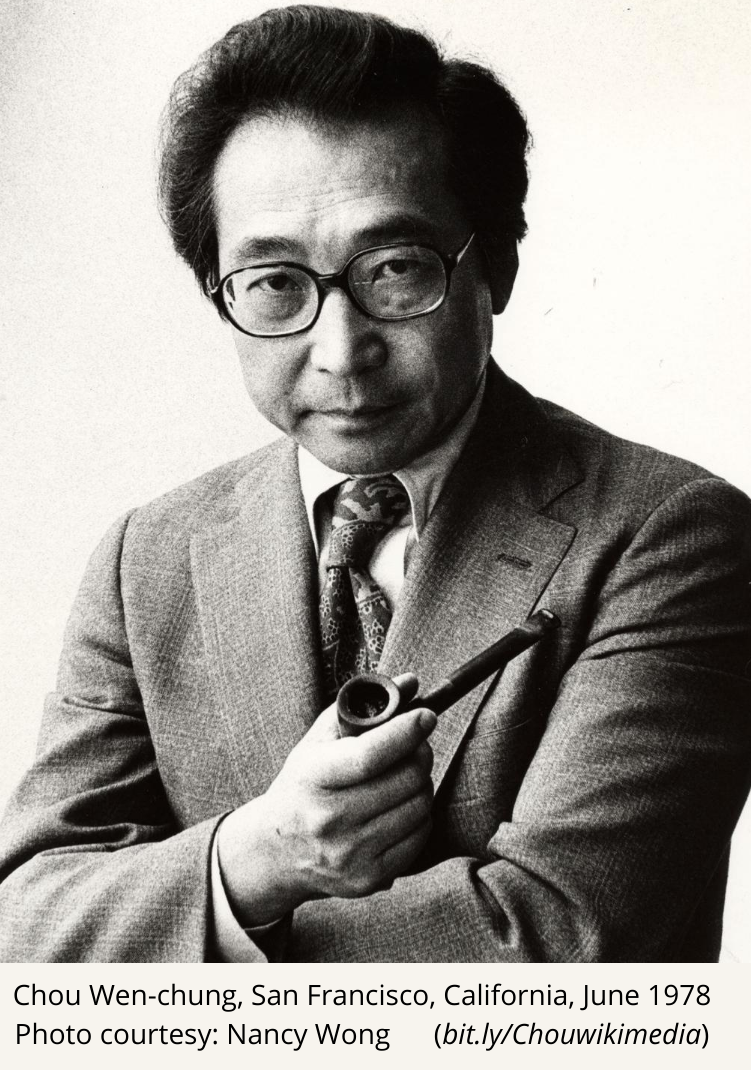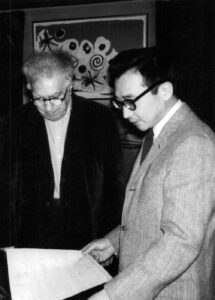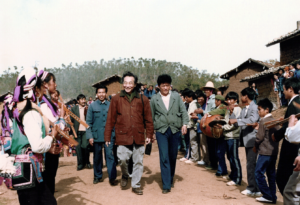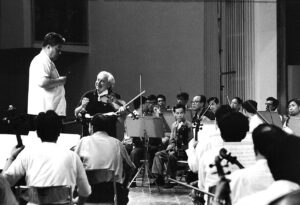
“One must search beyond the procedures of a musical practice, discern its original aesthetic commitments, and trace how its tradition has evolved. If one is blessed with a cross-cultural heritage, one must then regard it as a privilege and obligation to commit oneself to the search in both practices”
– Chou Wen-chung1
Today’s Spotlight is on the Chinese-American composer Chou Wen-chung, (1923-2019) a composer who seamlessly integrated Eastern and Western aesthetic principles into a highly original and influential new musical language. Described as “the godfather of Chinese contemporary music” by composer Tan Dun, 2 Chou felt a responsibility to build his career, in his own words, “on the basis of how to revive the Chinese heritage, and in view of the time lag, to merge with modern ideas.” (New Music Box Interview) 3
Born in Chefoo, China on July 29, 1923, Chou was homeschooled until the age of 11 due to a heart condition. 4 He had daily lessons in calligraphy and poetry from his father, and both art forms would go on to influence his compositional thinking greatly.5 Of calligraphic art, Chou wrote: “its expressiveness hinges on the spontaneous movement of the brush under the calligrapher’s control to project density, texture, and poise.”6 Chou attempted to recreate this same expressivity and flow in his own compositions, saying of the relationship between his compositional process and calligraphy: “you have to think of the whole piece right away! – including density and color and stress, and then do your best to bring it to life.” 7
He taught himself violin, mandolin, and harmonica as a child, but did not begin his formal musical training until he was 15, when he enrolled in violin lessons at the Shanghai Music School. In 1941 Chou fled Japanese-occupied Shanghai, traveling from place to place for the next four years, separated from his family and witnessing many horrors of the war. 8 Of this period, his son Sumin said: “in some ways he was driven to use music to heal himself.” 9
After receiving a civil engineering degree from National Chonqing University, Chou came to the U.S. on an architecture scholarship to Yale University. His goal was to rebuild his war-torn country, however, he turned down his scholarship to Yale after realizing that he could best accomplish this rebuilding through music. Chou went on to study with composer Nicholas Slonimsky at the New England Conservatory. 10 After earning a Bachelor’s degree there, he moved to New York City, where he briefly studied with the Czech composer Bohuslav Martinů. He was shortly thereafter introduced to composer Edgard Varèse, who would become a life-long mentor, colleague, and friend. Varèse was impressed by Chou’s orchestral work Landscapes after reviewing it in their first lesson together, and after only a few months of lessons asked Chou to be his assistant and copyist. Chou would become Varèse’s literary executor after his death, editing and completing many of his works and collaborating with Decca Records on the release of Varèse’s complete works. 11

Source: https://chouwenchung.org/about/edgard-varese/
Chou earned his Master’s in composition from Columbia University under Otto Leuning and Henry Paul Lang in 1954, and ten years later became a professor of composition at Columbia University. He had an illustrious career at Columbia University, having served as the Chairman of its Composition Department (1969-1991), Chairman of the Music Division of its School of the Arts (1969-1989), and Vice Dean of its School of the Arts. (1976-1987). Chou also created the first doctoral program in composition at Columbia, established the Fritz Reiner Center for Contemporary Music at the University, and expanded the scope of Columbia’s music curriculum, developing courses on “Chinese Music” and “Asian Humanities in Music.” 12 Among his many eminent students were several of the next generation’s most prominent Chinese composers, including Pulitzer Prize winner Zhou Long, Oscar winner Tan Dun, MacArthur Foundation Fellow Bright Sheng, and Guggenheim Fellow Chen Yi.13 Tan Dun said of Chou: “he was the only one who could share a very deep knowledge of the traditions of China, but also bring us into a completely new world. He was the one who built a dream for us.” 14

Photo courtesy of Sumin Chou / CC BY-SA
His many accolades include: two Guggenheim Fellowships, a National Institute of the Arts and Letters Award, commission grants from the Koussevitsky Music Foundation and the National Endowment for the Arts, honorary memberships of the Asian Composers’ League and the International Society for Contemporary Music, a John D. Rockefeller 3rd Award, a University of Cincinnati Award for Excellence, and the insignia of Officer of the Order of Arts and Letters of France. 15 Chou also served as President of Composer’s Recordings, Inc., (1970-1975) Chairman of the New York State Council of the Arts Music Panel, (1979-81) and Chairman of the Editorial Board of the musicological journal Asian Music (1972-74). 16

Photo courtesy of Sumin Chou for The Center for US-China Arts Exchange.
In 1978, Chou formed the Center for United State-China Arts Exchange at Columbia University, which seeks to “promote mutual interest in and understanding of the arts of the United States and China,” and has built significant cultural ties between the two countries over the last four decades. Among the Center’s first projects were arranging violinist Isaac Stern’s first visit to China in 1979, and playwright Cao Yu’s lecture tour of the U.S the following year. 17
The first composition we would like to share is The Willows are New, dating from 1957. This solo piano work takes as its primary material a traditional Chinese piece for guqin (a plucked seven-string Chinese instrument), which was based on a poem by Wang Wei (689-759). Chou writes that “mutations of the original material are woven over the entire range of the piano and embroidered with sonorities that are the magnified reflexes of brushstroke-like movements.”
The title of the work comes from the following excerpt of Wang Wei’s poem, as translated by Chou. 18
In this town by the river,
Morning rain
Has cleared the light dust.
Green, green around the tavern,
The willows are new. (1)
Let us empty another cup of wine
For, once west of Yang Kuan (2)
There will be no more friends.
(1) Sprigs of willow, used in farewell ceremonies, are a symbol of parting.
(2) Yang Kuan is a mountain pass, known as the point of no return for a traveler.
The second work we would like to share, a double trio for woodwinds and strings titled Twilight Colors, was written in 2007 for the Koussevitsky Foundation. Chou writes about this work:
“This piece is inspired by the exceptional colors of the changing sky over the Hudson River Valley…The texture of the twilight sky, with its rich monochromatic hues, tranquility devoid of sharp contrasts and streaks of parallel yet non-parallel lights, undergoes a subtle and continual change. This process of transformation in nature is reflected in the multi-linear texture, timbre, harmony and rhythm of the music, and becomes apparent only after the composition was well underway.
In conceiving the piece, I was influenced by the Chinese brush painters of the early 17th century who adopted fundamental brush stroke techniques from Chinese calligraphy to develop a landscape painting technique based on subtle brushstrokes and their sophisticated organization.” 19
The last piece we would like to share is Eternal Pine III from 2012. It was composed for a traditional Chinese ensemble of string and wind instruments known as sizhu. Chou writes of the piece’s connection to ink-brush painting and guqin music: “the inner vitality of the work expresses itself through dots and lines, pause and hesitation and tianbai (filling in the intervallic space left open in the modal or linear design).” The ensemble of instruments – guzheng, dizi, guan, pipa, sheng, and gu – traditionally represent seasonal changes in Southern China, and the “pine” symbolizes longevity and creativity in East Asian Cultures. 20 Chou’s Eternal Pine series includes two works for traditional Korean instruments, one work for traditional Western instruments, and two works for traditional Chinese instruments. 21 Although written towards the end of his life, these were the first works that Chou ever wrote for traditional Asian instruments. 22
“Compositions – Cursive.” Chou Wen-Chung, Composer, Teacher & Cultural Ambassador 1923-2019, https://chouwenchung.org/composition/cursive/






Thank you for this posting, i increasesd my knowledge on probably very known composers.